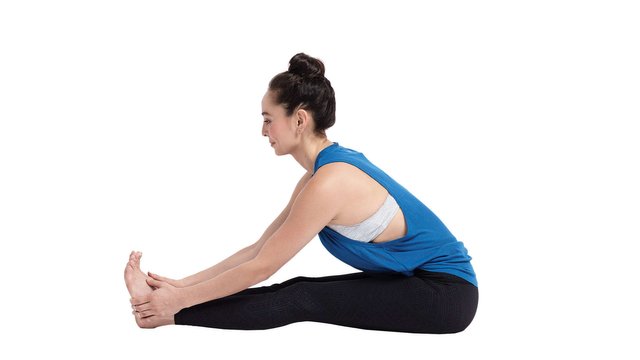Paschimottanasana or Seated Forward Bend in ancient yoga texts
Have you ever felt that no matter what you do it feels like you are chasing your own tale? Are you tired of your current life and you want to change it? Have you ever wanted to start it with a clean slate? Do you want the Change? With a capital "C". Then I suggest you start doing something about it. And why don't you start with your self first. You decide what to about it but I would very much suggest to dedicate a couple of minutes of your busy day to yoga practice. This may look like a very small step. But I believe it will be a giant leap for humanity.
There are dozens of different yoga exercises and hundreds of different poses or asanas. A lot of them you can find on the Internet. But... Unfortunately, we have very little information on where all these poses come from. What are the source ancient yoga books which describe these poses? The purpose of this particular article is to collect as much information from ancient yoga manuscripts as possible on what we currently know about paschimottanasana or seated forward bend. This is one of hundreds of different yoga postures. Hundreds of articles are dedicated to its performance, step-by-step instructions, contraindication and caution but almost none to the description of what ancient source books say to us about it. However, we have to understand what this pose at least looks like.
How to do Paschimottanasana or Seated Forward Bend
Before you learn how to do Seated Forward Bend and I hope include in your daily routine there are certain points that you might be interested in. Asana is defined as "a stable and comfortable position". They key word in practicing yoga is harmony. The only person who can tell you whether you feel harmony is you yourself. A yoga instructor or teacher can only help you find it. You have to be guided by your inner feeling of harmony in a pose and always check them whether the cues of teacher resonate with the feeling of harmony inside. Ancient yoga teachers knew this golden rule of yoga that "no person but yourself can show you how to do the pose". This is why the description of asanas in ancient manuscripts unlike in modern books on yoga is very terse.
This is like you teach someone to ride a bike. You say, "sit on the seat and start pedalling trying to find balance". Only you yourself can understand what balance, harmony and comfort is. The same thing in yoga poses. Very short description and according to it you open each pose yourself. The words of a teacher or a book only sign-post on the way to inner harmony. See for yourself. This is how paschimottanasana is described in the book I personally recommend. It is called "Easy yoga guide for beginners: Simple 46 Hatha Yoga Poses for Body and Mind". It has all information a newbie might need to start practice yoga.

POSE FOR THE STOMACH – PASCHIMOTTANASANA
"This is a pose for the stomach.
- Lie down on the ground
- Inhale and put your arms above your head
- Then exhale and bend forward
- Grasp your ankles by hands
- Make sure your legs and knees are straight
- Remain in this position and let the energy flow inside you
- Then touch your knees with your forehead
By doing this pose, you will get rid of any illnesses in your abdominal area; you will feel joy."
And that is it. Very terse and laconic. Being guided by the book I gave use this and other instructions to start practice yoga and change the world around you by changing yourself.
Paschimottanasana or Seated Forward Bend in ancient yoga texts
If you encounter description of paschimottanasana in the original source books on yoga then you will notice that they are very short. Two or three sentences and that's it. This description is very very terse. Also the pose that is performed in one way may have a lot of different names. Also a pose with the same name may be performed in many ways. These descriptions in different manuscripts may differ a lot. These rules apply to seated forward bend pose as well. See for yourself.
The classic fifteenth-century Sanskrit manual on hatha yoga, written by Svāmi Svātmārāma called Hatha Yoga Pradīpikā thus describes Paschimatanasana (notice it is not Paschimottanasana)
"Having stretched the feet on the ground, like a stick, and having grasped the toes of both the feet with both the hands, when one sits with his forehead resting on the knees, it is called Paśchima tāna."
As you can see although a lot of yoga encyclopedias call it Paschimottanasana, it is called in this ancient text
Paschima-tana-asana. At least in this very popular medieval text Hatha Yoga Pradīpikā.
Further, the author says,
"This Paśchima Tâna carries the air from the front to the back part of the body (i.e., to the suṣumna). It kindles gastric fire, reduces obesity and cures all diseases of men.".
As you can see the name of the pose slightly differs from what we are used to, that is Paschimottanasana. I mean in Hatha yoga pradipika the syllable "ut" is omitted.
Another treatise describing paśchima-tâna-asana is called Hatha-ratnavali or "necklace of hatha yoga".
Hatharatnavali is an important treatise on Hathayoga and Tantra written by Srinivasa Bhatta Mahayogendra (1625-1695 A.D.) but not popular as Hatha Pradipika of Atmarama. (1534-1634 A.D.). The date of Hatha-ratnavali's composition is uncertain. As you can see this is a medieval treatise as well. Chapter three lists more than 76 asanas and gives an elaborate description of 36 of them.
There will be dozens of other yoga scriptures in this and other articles. So do not hesitate to get involved. Resteem, upvote and follow.